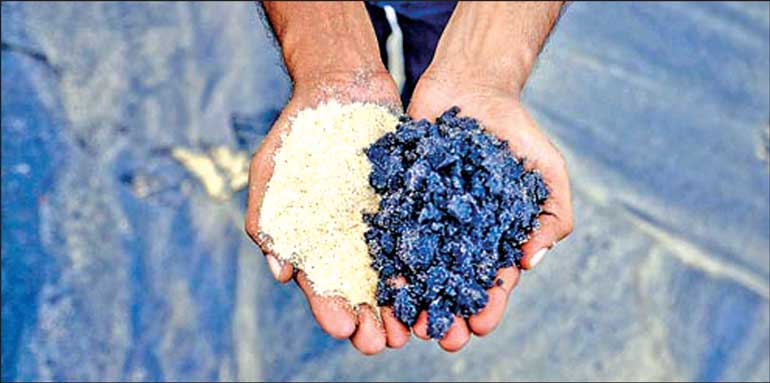Saturday Sep 07, 2024
Saturday Sep 07, 2024
Friday, 26 July 2024 00:02 - - {{hitsCtrl.values.hits}}

Sri Lanka’s agriculture and mineral policies need overhauling along with fresh thinking and national minded leadership
By Kumar Ranaweera
Sri Lanka sits on a wealth of resources, but let it all go to waste. Agriculture was one such historical natural strength in what used to be the ‘Pearl of the Indian Ocean,’ bringing fame and fortune from far and wide. Today, we import rice, coconuts and other agri-commodities – a far cry from former glory. Skewed agricultural policy perpetuated by the lack of political will burns holes in the future potential of an industry and our people.
Agriculture that bears no fruit
Opportunity was lost, and entire generations rendered poor. One fine example is the Paddy Lands Act of 1958. At the outset, that this act was drawn up in 1958 and its still in use here today in 2024 is telling. The Act claims to offer greater security to tenants of paddy lands and enable the authority to cause the cultivation of such lands. What it did instead is cause endless land disputes over generations, depress landowners and enslave farmers into a cycle of poverty from where there is no escape. No politician will take up the matter as votes are more important for them over the short-term, as opposed to the long-term growth of the people and nation. Our historical strength and advantage was wiped out.
Graphite at breaking point
At the turn of the 20th century, Sri Lanka held another potential jewel in its crown – the mineral industry; yet another sector with which we have not dug deep. Sri Lanka once was the largest exporter of graphite to the US, UK and Germany. Following discovery of similar compounds of graphite in Madagascar with cheaper labour and costs, the competition weakened our market share before mismanagement and corruption saw the demise of the industry post nationalisation in 1971. Sri Lanka hardly exports 10,000 metric tonnes of graphite at present. The country’s graphite deposits hold up to 1.5 million tonnes. Though this is insufficient to meet large-scale demand, the quality and composition presents significant opportunity. But what have we done in this regard? In the absence any progress from Sri Lanka, India has made overtures to acquire the graphite mines identifying its quality and proximity. Sri Lanka had listed graphite as one of thirty critical minerals in the country, but it will merely remain a listing.
Unproductive rich phosphate
The same fate has befallen our phosphate deposit. Considered one of the most unique and richest deposits in the world. Yet, Lanka Phosphate hardly musters a reasonable profit. The Auditor General in his review of the financial statements for the year 2022/2023 states: “Necessary steps should be taken to maintain the quality of products as products not being up to desired standard can adversely affect the sales of the company, causing problems regarding the accuracy of the information provided by the company. The stock of 3,173 metric tons of fertiliser sold after conducting quality checks from the said machine was returned to the company as it did not meet the expected standards.” This sums up the status of one of the richest phosphate deposits in the world.
Ill-befallen Ilmenite
In a similar vein, Sri Lanka sits on an equally rich deposit of ilmenite that has been bandied about in text books for over 50 years. But that deposit too is restricted to the ground as authorities are unable to do what’s necessary to bring that to the fore. Mineral exploration is a long and resource-intense industry, which has been done with the help of foreign investment. Unlike graphite, minerals like phosphate and ilmenite require significant value addition. Sri Lanka simply does not have the expertise locally to make that turn. But again, there is a lack of political will to put in place the necessary synergies and expertise to capitalise on the global stage. Instead, the political machinery is adept to afford mining rights to hitherto unknown companies that can muster no real value for the country and its minerals on the global stage.
Supply critical materials
If done right, the above segments have the potential to garner over $ 4 billion in annual earnings for Sri Lanka, but instead we choose to potter about in a suboptimal state. This dystopia is the fallout of our political leadership and the people who blindly vote them in. Sri Lanka must pay more attention to its resources, and supply critical materials such as our minerals must be protected and promoted with the right expertise and care. The world is paying greater attention to the supply of raw materials, with the EU in particular regularly reviewing its list of critical materials to ensure unhindered access. Natural graphite, natural rubber, phosphate are some of the materials on the EU list, and items that Sri Lanka has the capacity to offer. What will we do about them? Sri Lanka’s agriculture and mineral policies need overhauling along with fresh thinking and national minded leadership.
(The writer is a Research Associate attached to a leading Auditor in Colombo specialising in consumer behaviour, product and trade policy.)